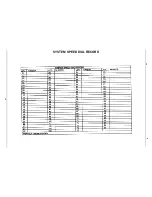
INTEGRATED CALL COSTING
Call costing provides a means of establishing costing to be applied to outside calls made from system telephones.
Call costing computes charges for
a
call after it is completed. It does not restrict dialing as toll restriction does. The system provides several ways of establishing call costing. They are
as follows:
l
Exception tables
l
Area code band tables
l
Zone call band tables
l
Call rate tables
l
Office code band tables
l
Call rate table of last resort
With this range of costing methods, it is possible to apply reasonable rates for the entire country.
Call costing is applied to a dialed number as
described below. The call costing process is illustrated by the diagram shown in
Figure 4-2.
1. EXCEPTION TABLES (LOCAL CALLS AND LONG DISTANCE CALLS)
All calls are first compared to entries in 4 exception tables (one entry per table). These tables provide the first orioritv level of costing.
The tables are
searched on a first match basis. This means that the first programmed entry that matches the call is the one that is used. A search is not made for the
best possible match. Matched calls are costed with values programmed into the call rate tables that are assigned to the exception tables. Use
exception tables to provide very specific exceptions to a bracket of calls similar to the following example.
Example:
With all calls to area code 804 costed per a particular rate, make an exception for 804-555-1212 by programing exception table 1 with that
number. Since exception table entries are the highest priority, the values in the call rate table assigned to exception table 1 are applied to all calls
made
to the 804-555-l 212 number.
2. OFFICE CODE BAND TABLES (LOCAL CALLS)
Calls
that
do not match exception tables are measured for the number of digits dialed. Calls with numbers that are have less than 10 digits (local calls)
are compared to entries in office code banding tables. Office code band tables are the second
level of costing for local calls.
They provide a
means of assigning local office codes into different bands and applying a separate call costing rate table to each band.
Bands 1 7 are associated
with call rate tables 18 24 respectively. Use office code band tables to cost calls made within a specific area code but to sites located at different
geographic distances from the calling location.
Example:
A telephone company exchange consists of office codes 976,977, and 978.
Off ice code 976 is assigned to an outlying area while off ice
codes 977 and 978 are assigned to the heart of the city.
Assign 977 and 978 to one office code band table and 976 to another one.
Program a special
call costing rate for each banding table. Then, calls that are made to 976-nnnn are costed at a different rate than calls that are made to 977-nnnn or
3. ZONE CALL BAND TABLES (LONG DISTANCE CALLS)
In certain heavily populated geographic areas, different area codes exist within the same geographic distance, or zone, from the calling location.
I n
these cases, use zone call band tables to cost calls based upon the zone, or geographic distance, from the caller.
All calls that do not match exception tables are measured for the number of digits dialed. Those calls with numbers that have 10 digits or more (long
distance calls) are compared to entries in the zone call band tables. Zone call band tables are the second orioritv level of costing for long distance
calls. They provide a means of assigning office
codes
and corresponding area code into different zones and applying a separate call costing rate table
to each zone. Zone call band tables 1 4 are associated with call rate tables 25
28. A call must match both the office code and area code of an entry
before it is costed by a zone call band table.
Example:
Zone 1 contains area code 203 with office codes 445 and 456.
It also contains area code 412 with office code 508. Zone 2 contains area
code 203 with office code 545. Zone 2 also contains area code 412 with office code 654. Zone 1 is costed at one rate and zone 2 is costed at another
rate. A call made to
or, l-41
is costed at a different rate than a call made to
or
l-41
Summary of Contents for DIGITECH
Page 13: ...System Overview l 6 ...
Page 14: ..._ d33 System Overview J 0 I r0 0 0 t 0 0 0 0 0 0 0 0 0 l 7 ...
Page 41: ...IMI 66 083 Table 3 2 J l Statlon Connections 4 Line Station Base Unit SPARE PORTS ...
Page 47: ...IMI 66 083 Installat ...
Page 55: ...IMI66 083 Installat llllllilliiiiiliiiil5 TTTTTTITTTTTTTTTTTTT 1111111111111111111 E 3 21 ...
Page 62: ...installation IMI 66 083 Figure 3 16 Software Cartridge lnstallatlon and Removal 3 28 ...
Page 106: ...System hogramming IMI 66 083 STATION LINECONFIGURATIONRECORD ...
Page 110: ......
Page 111: ......
Page 112: ......
Page 113: ......
Page 137: ...LAST RESORT TABLE I U L COST T U 1 31TME 1 RATE q 2 RATF ICHARGE R2RATF 1 1 SURCHARGE 1 I ...
Page 138: ...COST TABLE 20 I SURCHARGE I 2 RATF SURCHARGE ...
Page 146: ...SYSTEM SPEED DIAL RECORD ...
Page 181: ...Sjlstem Gperation IMI 66 083 ...
















































